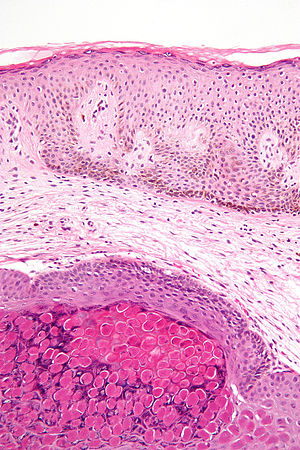Difference between revisions of "Molluscum contagiosum"
Jump to navigation
Jump to search
(→Images) |
|||
| Line 74: | Line 74: | ||
Image:Molluscum_contagiosum_low_mag.jpg | Molluscum contagiosum - low mag. (WC) | Image:Molluscum_contagiosum_low_mag.jpg | Molluscum contagiosum - low mag. (WC) | ||
Image:Molluscum_contagiosum_1.jpg | Molluscum contagiosum. (WC) | Image:Molluscum_contagiosum_1.jpg | Molluscum contagiosum. (WC) | ||
Image:Molluscum contagiosum0001.jpg | Small molluscum contagiosum. (WC) | |||
</gallery> | </gallery> | ||
==Sign out== | ==Sign out== | ||
<pre> | <pre> | ||
Revision as of 12:31, 14 March 2014
| Molluscum contagiosum | |
|---|---|
| Diagnosis in short | |
 Molluscum contagiosum. H&E stain. | |
|
| |
| LM | large suprabasilar epidermal cells with (granular) eosinophilic cytoplasmic inclusions that usually fill the cytoplasm; small peripheral nucleus |
| Gross | dome-shaped papules, flesh coloured or pearly |
| Site | skin, usu. face or trunk |
|
| |
| Prognosis | benign |
Molluscum contagiosum, abbreviated MC, is an infectious skin disease that is occasionally seen by pathologists. It very distinctive and, thus, an exam favourite.
General
- Etiology: caused by molluscum contagiosum virus.
- May be abundant in immune deficient individuals, e.g. HIV/AIDS.
Gross
Features:[1]
- Dome-shaped papules, flesh coloured or pearly.
- Usually face or trunk.
- +/-Central umbilication.
- Central depression.
DDx - gross:
Image
Microscopic
Features:[1]
- A suprabasilar epidermal lesion consisting of "molluscum bodies" -- in other words "molluscum bodies" are found above the stratum basale +/- extension to the skin surface.
- Molluscum bodies - key feature:
- Large cells with (granular) eosinophilic cytoplasmic inclusions.
- The inclusions usually fill the cytoplasm.
- Inclusions are usually one per cell... but may be multiple.
- Small peripheral nucleus.
- Large cells with (granular) eosinophilic cytoplasmic inclusions.
- Molluscum bodies - key feature:
- +/-Lymphocytes.
Notes:
- Molluscum bodies very vaguely resemble signet ring cells -- but:
- Cytoplasm is eosinophilic and granular.
- Nucleus usually smaller than in signet ring cells.
- Molluscum bodies are only in the epidermis - an uncommon place to find SRCs without finding them elsewhere.
- The granular eosinophilic cytoplasmic inclusions represents accumulated virons.
- Molluscum bodies "grow" toward the surface
DDx:
- Nothing really - it is very distinctive.
Images
Sign out
SKIN LESION ("SKIN TAG"), EXCISION:
- MOLLUSCUM CONTAGIOSUM.
Micro
The section shows fragments of skin with epithelium on three sides. Large suprabasilar cells with eosinophilic intracytoplasmic inclusions (molluscum bodies) and small eccentric nuclei are present, and extend to the skin surface. The epithelium is acanthotic; however, it matures to the surface. There is no significant inflammation.
See also
References
- ↑ 1.0 1.1 Busam, Klaus J. (2009). Dermatopathology: A Volume in the Foundations in Diagnostic Pathology Series (1st ed.). Saunders. pp. 115. ISBN 978-0443066542.
Cite error: Invalid
<ref>tag; name "Ref_Derm115" defined multiple times with different content




